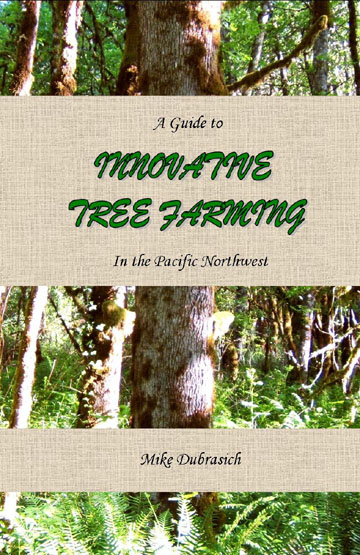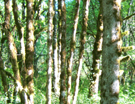Chapter 1: An Introduction to Innovative Tree Farming
From A Guide to Innovative Tree Farming in the Pacific Northwest by Mike Dubrasich. 2005. Whirlwind Press. For a hard copy of the book ($10 - includes shipping) please contact W.I.S.E. [here].

If you own rural property in the Pacific Northwest, then this book is for you. Tree farming is one of the best ways to use your property. It’s relatively easy, non-polluting, low maintenance, interesting, and it can be very profitable, too.
Tree farming is the art and science of growing, harvesting, and marketing large, woody plants. Trees are fascinating, lovely, noble, and enjoyable to grow. Tree farming is also a business, one that uses natural phenomena (plants, soil, rain, and sunshine) to produce commercial goods and materials. Most rural landowners grow trees on their property, and many of them make money harvesting sawlogs, Christmas trees, firewood, boughs, cones, or hundreds of other tree products. That’s tree farming. Many so-called “forests” in the Pacific Northwest are actually tree farms: plantations of trees grown to be commercially harvested. (Orchards and nurseries are also types of tree farms, but they are outside the scope of this book.)
Tree farming can be very profitable; the key is innovation. Traditional practices are uneconomical and antiquated in the light of expanding new markets for new tree farm products. Innovative tree farmers, those who take advantage of these growing opportunities, will enjoy the most financial success in the 21st Century.
Tree farming is a very big business, one dominated by huge corporations, but individual and family-owned tree farms vastly outnumber the big companies. There are over 100,000 tree farmers in the Pacific Northwest (by my definition, Oregon, Washington, British Columbia, northern California, southeast Alaska, Idaho, and western Montana, more or less). Non-industrial private forest landowners, small woodland owners, forest farmers, timber ranchers, and rural woodlot owners (as tree farmers are variously called) own about 15 to 20 percent of the “commercial forest” acres in the region.
Individual and family tree farmers face many challenges today, but one in particular stands out. Douglas-fir has been the traditional crop species in the Pacific Northwest, but growing Douglas-fir (timber) is a money-losing proposition for small and medium-sized ownerships. Douglas-fir grows too slowly, and is worth too little at harvest, to be a profitable crop for most of us. Individual and family tree farmers cannot compete successfully with multinational corporations and government agencies that own millions upon millions of acres of Douglas-fir.
The solution for most tree farmers is innovation. Innovation is the application of new ideas. To be a successful tree farmer today, and into the future, you need new crops, new techniques of growing and processing, new products, and new markets. Individual and family tree farmers have one advantage over big companies: we can change and adapt rapidly, and they cannot. New, untapped markets with untapped profits await the innovative and entrepreneurial. Innovation is the key to more profits, and more satisfaction for tree farmers.
In this book we look at the characteristics the ideal tree farm species should have. Then we discuss the best real species, and new ways to farm them. The list is not encyclopedic; these are my favorites, selected from 30 years of professional tree farm management and consulting. Innovative tree farmers are growing many other tree species not mentioned. My idea is to invite you to think about tree farming from a new perspective, and to inspire you to create and develop your own innovations.
One note of explanation: this book is about tree farming, not forest management. Tree farms are not forests. Tree farms and forests are different structurally, biologically, and ecologically, but their most important dissimilarity is in their separate purposes and usefulness to people. Tree farms are managed, primarily, as agricultural businesses that produce commodities. Forests are managed, primarily, to produce wildlife habitat, scenery, recreation, and to perpetuate natural ecosystems. Separately, both are beneficial land uses, but combination tree farm/forests are the worst of both possible worlds. Attempting to grow both on the same acre doesn’t work: you get an under-productive, inefficient tree farm, and an over-simplified, biologically limited forest.
Tree farming is good for the Earth. Trees prevent erosion, build soil and humus, and make oxygen from carbon dioxide and sunlight. As an attractive bonus, trees look good doing all these things. People plant trees on reclaimed toxic waste sites because trees can tolerate tough conditions, and they help to purify soil, air, and water. A few decades of tree cover is a good way to rejuvenate a worn-out pasture or field.
It’s a good way to rejuvenate people, too. Tree farmers, like trees, come in all shapes and sizes, but they share common traits: a love of the outdoors, moral strength, and the quiet satisfaction that comes from living in harmony with nature. Tree farming is not only good for the land; it’s good for the farmer, as well. The most important things grown on farms are children and their parents.
Tree farming can be a profitable and long-lived endeavor, one that can support many generations on the same land. Today, however, if supporting generations is your goal, then traditional tree farming may fail you. You need innovation.
